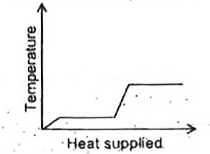A block of ice at −5∘C is slowly heated and converted to steam at 100∘C . The process can be qualitatively represented by the curve




The correct Answer is:C
To solve the problem of heating a block of ice at -5°C and converting it to steam at 100°C, we can break down the process into several steps and represent it graphically. Below is the step-by-step solution:
Step 1: Identify the Initial and Final States
- Initial State: Ice at -5°C
- Final State: Steam at 100°C
Step 2: Understand the Heating Process
The process involves several stages:
1. Heating the ice from -5°C to 0°C (sensible heat).
2. Melting the ice at 0°C to water (latent heat).
3. Heating the water from 0°C to 100°C (sensible heat).
4. Converting the water at 100°C to steam (latent heat).
5. Heating the steam from 100°C to a higher temperature (if needed, but in this case, we stop at 100°C).
Step 3: Calculate the Heat Transfer for Each Stage
1. Heating Ice from -5°C to 0°C:
- Use the formula: Q1=m⋅cice⋅ΔT
- Where cice is the specific heat capacity of ice and ΔT=0−(−5)=5°C.
2. Melting Ice at 0°C:
- Use the formula: Q2=m⋅Lf
- Where Lf is the latent heat of fusion.
3. Heating Water from 0°C to 100°C:
- Use the formula: Q3=m⋅cwater⋅ΔT
- Where cwater is the specific heat capacity of water and ΔT=100−0=100°C.
4. Converting Water at 100°C to Steam:
- Use the formula: Q4=m⋅Lv
- Where Lv is the latent heat of vaporization.
5. Total Heat Transfer:
- The total heat Qtotal=Q1+Q2+Q3+Q4.
Step 4: Graphical Representation
- On a graph with temperature on the y-axis and heat on the x-axis:
- From -5°C to 0°C, draw a sloped line (sensible heat).
- From 0°C to 0°C (phase change), draw a horizontal line (latent heat).
- From 0°C to 100°C, draw another sloped line (sensible heat).
- From 100°C to 100°C (phase change), draw another horizontal line (latent heat).
Step 5: Conclusion
The graph represents the heating process of ice at -5°C to steam at 100°C, showing both sensible and latent heat transfers.
- Initial State: Ice at -5°C
- Final State: Steam at 100°C
The process involves several stages:
1. Heating the ice from -5°C to 0°C (sensible heat).
2. Melting the ice at 0°C to water (latent heat).
3. Heating the water from 0°C to 100°C (sensible heat).
4. Converting the water at 100°C to steam (latent heat).
5. Heating the steam from 100°C to a higher temperature (if needed, but in this case, we stop at 100°C).
1. Heating Ice from -5°C to 0°C:
- Use the formula: Q1=m⋅cice⋅ΔT
- Where cice is the specific heat capacity of ice and ΔT=0−(−5)=5°C.
- Use the formula: Q2=m⋅Lf
- Where Lf is the latent heat of fusion.
- Use the formula: Q3=m⋅cwater⋅ΔT
- Where cwater is the specific heat capacity of water and ΔT=100−0=100°C.
- Use the formula: Q4=m⋅Lv
- Where Lv is the latent heat of vaporization.
- The total heat Qtotal=Q1+Q2+Q3+Q4.
- On a graph with temperature on the y-axis and heat on the x-axis:
- From -5°C to 0°C, draw a sloped line (sensible heat).
- From 0°C to 0°C (phase change), draw a horizontal line (latent heat).
- From 0°C to 100°C, draw another sloped line (sensible heat).
- From 100°C to 100°C (phase change), draw another horizontal line (latent heat).
Step 5: Conclusion
The graph represents the heating process of ice at -5°C to steam at 100°C, showing both sensible and latent heat transfers.
Topper's Solved these Questions
- THERMAL PROPERTIES OF MATTERBOOK - MODERN PUBLICATIONCHAPTER - THERMAL PROPERTIES OF MATTEREXERCISE - COMPETITION FILE (OBJECTIVE TYPE QUESTION ((B) MULTIPLE CHOICE QUESTION FROM CPMPETITIVE EXAMINATION ) AIMPMT/NEET AND OTHER STATE BOARDS FOR MEDICAL ENTRANCE)
18 Videos
- THERMAL PROPERTIES OF MATTERBOOK - MODERN PUBLICATIONCHAPTER - THERMAL PROPERTIES OF MATTEREXERCISE - COMPETITION FILE (OBJECTIVE TYPE QUESTION ((B) MULTIPLE CHOICE QUESTION FROM CPMPETITIVE EXAMINATION ) JEE MAIN AND OTHER STATE BOARDS FOR ENGINEERING ENTRANCE)
19 Videos
- THERMAL PROPERTIES OF MATTERBOOK - MODERN PUBLICATIONCHAPTER - THERMAL PROPERTIES OF MATTEREXERCISE - REVISION EXERCISE (NUMERICAL PROBLEM)
19 Videos
- SYSTEMS OF PARTICLES AND ROTATIONAL MOTIONBOOK - MODERN PUBLICATIONCHAPTER - SYSTEMS OF PARTICLES AND ROTATIONAL MOTIONEXERCISE - Chapter Practice Test (for Board Examination)
16 Videos
- UNITS AND MEASUREMENTBOOK - MODERN PUBLICATIONCHAPTER - UNITS AND MEASUREMENTEXERCISE - CHAPTER PRACTICE TEST
15 Videos
Similar Questions
Knowledge Check
A block of ice at −12∘C is slowly heated and converted into steam at 100∘C. Which of the following curves best represents the event ?
A B
B C
C D
D
A block of ice at −10∘C is slowly heated and converted to steam at 100∘C. Which of the following curves represents the phenomenon qualitatively?
A B
B C
C D\
D\A block of ice −10∘C is slowly heated and converted to steam at 100∘C. Which of the following curves represent the phenomenon qualitatively?
A B
B C
C D
D
A block of ice at 0∘C is converted to steam at 100∘C. Which process will require the most amount of heat?
View Solutiona block of ice at temperature −20∘C is slowly heated and converted to steam at 100∘C which of the following diagram is most appropriate
View Solutiona block of ice at temperature −20∘C is slowly heated and converted to steam at 100∘C which of the following diagram is most appropriate
View SolutionA block of ice at temperature −20∘C is slowly heated and converted to steam at 100∘C. Which of the following diagram is most appropriate?
View Solution1g of ice at 0∘C is mixed 1g of steam at 100∘C. The mass of water formed is
View Solution
